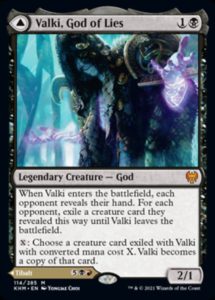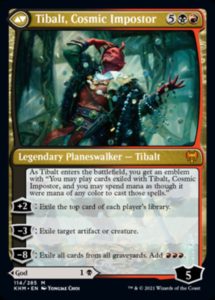Kaldheim has been one of the most exciting sets for me in quite a while, and I’m excited to dig into this set’s Top 10s for Oathbreaker. To be more specific, I’ll be doing a Top 10 article for cards of each color, as well as one for multicolor cards. The last pair of Top 10s for this set will be one covering the colorless/land/theme booster exclusive cards and one covering all the new cards from the Commander precons (plus my overall Top 10 cards from Kaldheim, of course). My Top 10s are based on 1) how strong I think a card will be in Oathbreaker, and 2) how many different types of Oathbreaker decks I expect the card to see play in. While I do try to be as objective as I can, these are ultimately just my own thoughts/opinions.
In regards to Kaldheim, I’d also like to reiterate one important factor at the beginning of each of these articles: no, foretell does not work the way you want it to with Signature Spells. Your Signature Spell can only exist either 1) in the command zone, or 2) on the stack. It cannot go to exile—or anywhere else—for any reason, meaning you can not foretell a Signature Spell.
With all that out of the way, let’s keep things moving with my Top 10 Multicolor cards from Kaldheim!
Honorable Mentions
This latest version of Tibalt is definitely my personal favorite iteration of the little devil, which makes it that much more painful to say he’ll probably see a pretty limited amount of play in Oathbreaker. To be clear, Tibalt, Cosmic Imposter can not be used as an Oathbreaker since the front side of the card is a creature—that is to say, the official rules state this Tibalt can’t be an Oathbreaker. Rule 0 is still a thing, and I imagine there will be plenty of Oathbreaker players that will be happy to let you play your Rakdos Tibalt deck. Seven mana is a pretty high mana-cost for an Oathbreaker, especially for one without access to green ramp; however, I do very much enjoy this Tibalt’s theme of “borrowing” your opponents’ cards via his various exiling abilities. As for the “god” half of this card, I’m not particularly excited. Valki is mana-efficient enough for the format, but you can also only transform him once due to the card’s templating. Even still, I look forward to making Tibalt, Cosmic Imposter work in both Oathbreaker and EDH.
#10: Battle for Bretagard
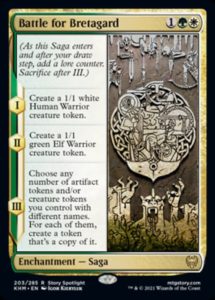
Kaldheim brought along about 20 new multicolor sagas, which I’m a pretty big fan of as a whole. Battle for Bretagard is definitely one of the flashier of these sagas—well, at least as far as its final chapter is concerned. Creating a couple of extra 1/1s isn’t that exciting, but in a deck built around generating a variety of different artifact and/creature tokens, this third chapter can net a ton of extra value. Battle for Bretagard was kept this low on the list due to the fact you do really need to resolve all three of this saga’s chapters in order to get your mana’s worth out of it. That being said, I’m sure this card will prove its power in dedicated token strategies in Oathbreaker.
#9: King Narfi’s Betrayal
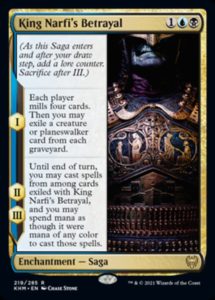
To be totally honest, this next saga didn’t especially excite me when I first read it; however, it’s grown on me quite a bit since then. Paying three mana to mill each player for four isn’t a very good rate on its own, but this saga becomes much more interesting once you hit its next chapter. In combination, this saga’s two chapters act somewhat similarly to Gonti, Lord of Luxury—except this effect grants you access to several more cards, of course. Despite the high ceiling on King Narfi’s Betrayal, there are a few notable downsides; 1) you do really need to hit this card’s second chapter—at the least—in order to get your mana’s worth, and 2) you’re still left with a pretty limited window to play any of the exiled cards. Even still, this saga seems like a fun new option fir control and/or theft decks in Oathbreaker, and perhaps even some mill strategies.
#8: Binding the Old Gods
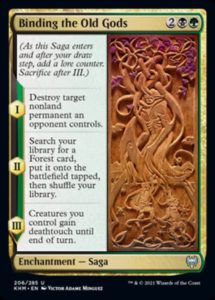
Binding the Old Gods is certainly one of the simpler new sagas from Kaldheim, but “simpler” isn’t always a bad thing—quite the opposite, in this case. At the bare minimum, this saga acts as a pretty solid piece of spot removal that can even be aimed towards an opposing Oathbreaker. The added ramp from the second chapter makes this card a bit more worth the cost, and while the third chapter may prove impactful in certain scenarios, I think it’s the least important part of the card. Perhaps most notably, Binding the Old Gods is only an uncommon, meaning it should be both widely accessible and budget-friendly for incoming and invested Oathbreaker players alike. There’s nothing earth-shatteringly powerful about Binding the Old Gods, but I suspect it will make for a fine new budget staple for green/black decks in Oathbreaker.
#7: Immersturm Predator
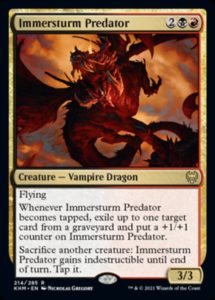
Can we just take a moment to appreciate the sheer amount of coolness this card emanates? MTG’s first vampire dragon has not disappointed me, and I hope to see even more of this creature type combination in the future. I’ve also always been a fan of Rakdos-colored sacrifice shenanigans, and Immersturm Predator is a very fun new toy for such archetypes. Being a free, repeatable sacrifice outlet that protects itself is already quite the accomplishment, but the rules text doesn’t end there. This flyer can also passively act as a pseudo Scavenging Ooze whenever it becomes tapped, whether it’s from attacking, sacrificing a creature, crewing a vehicle, or something else entirely. I suspect Immersturm Predator will primarily end up being a spicy new inclusion for Rakdos aristocrat strategies, but I could also see it popping up sporadically in other archetypes, such as vehicles or more generic monsters lists.
#6: Kaya the Inexorable
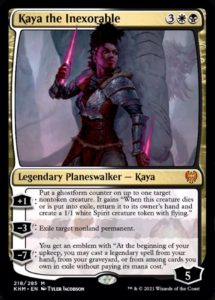
I’ve always been a fan of Kaya’s character/abilities, but I think this latest iteration is my favorite version of her yet. Instead of simply phasing in and out herself, it’s cool to see her ability extend to giving other creatures “ghostform counters”. The strength of this +1 ability is a little subtle, but I could see it working well in a sacrifice-centric list or most any creature-based deck. This ability can also be used politically (note that it says any nontoken creature), though I’m not sure how often it will actually come up. Kaya’s -3 ability is a more generically-strong effect, especially in a format where it’s so important to be able to interact with opposing planeswalkers. Her -7 ability is a bit more unusual, and I’m not entirely sure why it was chosen for this particular card; however, if you’ve been waiting for an Orzhov-colored Oathbreaker that pairs well with Primevals’ Glorious Rebirth, here you go! I personally expect to see Kaya the Inexorable show up in the 58 more often than not, but I’m sure she’ll make a fine Oathbreaker in her own right.
#5: Niko Aris
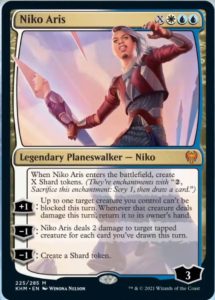
I’m really excited about Niko Aris as a new character in MTG lore, and I’m glad to see them receive such an interesting planeswalker card. Niko is the first planeswalker to be printed with X in their mana cost since Nissa, Steward of Elements, and their X value doesn’t actually affect their incoming loyalty value. Instead, Niko creates X “shard” enchantment tokens, which can be sacrificed for extra cards (now that’s an Azorius effect if I’ve ever seen one). The rest of Niko’s abilities are interestingly diverse; they can create more shards on their own, and they can even help turn card draw into creature removal with their first -1 ability. Oddly enough, Niko’s +1 ability doesn’t really have anything to do with the rest of the card, but I could see it being utilized in a variety of different decks. Blink strategies can also utilize any self-bounce effects, and unblockability can always be put to good use in most creature-based lists. I’m curious to see how the rest of the Oathbreaker community chooses to build around Niko, and I’m pretty excited to starting brewing with them, myself.
#4: Tyvar Kell
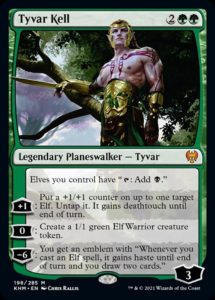
Ugh, I just wrote an article with green/black elves back when Commander Legends came out! Guess I’ll be writing a “Flashback” article about that list sooner than I thought, because we’ve got ourselves a new Golgari Oathbreaker who is all about elf tribal. Tyvar Kell‘s abilities are pretty much exactly what I would expect out of an elf tribal planeswalker; he makes elves, makes your elves bigger, makes your elves tap for mana, and makes your elves draw you cards. Perhaps even more importantly, Tyvar does all of these cool things in a way that seems strong, but not too strong. Aside from his ultimate ability—which will usually take a little while to build towards—Tyvar’s abilities aren’t too threatening on their own, but they each still provide their own form of value. This elf-with-abs didn’t earn a higher spot on this list simply because he’s really only built for elf tribal, but I’m sure he’ll become a pretty popular Oathbreaker for that particular archetype.
#3: Sarulf, Realm Eater
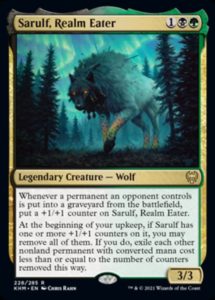
Oh, now we’re talking. Y’all probably know how much I enjoy cards that scale well into multiplayer formats, and this big, bad wolf is a perfect example. In a four-player game, Sarulf can become very large very quickly. You can also choose to turn their accumulated strength into a form of board wipe that’s somewhat reminiscent of cards like Pernicious Deed—with the key differences being that this effect exiles cards and doesn’t cost extra mana. Then again, you can always choose to keep the counters around and hound your opponents with your enormous wolf. It’s also worth noting that Sarulf’s second ability uses +1/+1 counters they gained from any source, so this card could prove especially devastating in a dedicated +1/+1 counters deck. Even outside of such strategies, Sarulf is a generically-strong enough card that I could see them being utilized in most Golgari Oathbreaker lists.
#2: Kardur, Doomscourge
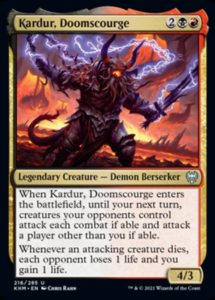
Oh. My. Goodness. Political shenanigans and sacrifice-based shenanigans? On the same card? I thought Christmas was over?! In all seriousness, Kardur is a very exciting new legend that seems perfectly built for a multiplayer format like Oathbreaker. His enter-the-battlefield is essentially a slightly-upgraded Disrupt Decorum, which is already spicy enough on its own; however, the fun doesn’t end there! Kardur also punishes all of your opponents whenever any attacking creature dies, and he even gives your life total a little buffer in the process. This type of triggered ability is pretty well-positioned in a multiplayer format, though it becomes even more powerful in a dedicated sacrifice-based strategy. Kardur kind of functions like a Blood Artist, except he only triggers during combat and he drains each opponent. I could be a bit biased in my ranking here since I just think Kardur is really sweet, but I suspect a lot of players are going to have fun brewing with this fun little demon in Oathbreaker.
#1: Koma, Cosmos Serpent
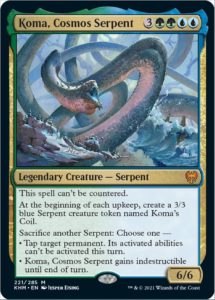
Well, at least this Simic-colored legend isn’t the stereotypical “ramp & card draw” combo we’ve seen so much of in the last few years; however, Koma, Cosmos Serpent is no less powerful for their uniqueness. If anything, I’d say they might be one of the strongest Simic cards printed in the last few years—for Oathbreaker, anyways. Creating a 3/3 serpent creature token at the beginning of each upkeep is an ability that would’ve earned Koma a high spot on this list on its own, but Koma can also sacrifice other serpents for additional value. More specifically, they can sacrifice serpents to either protect themselves or to turn off another permanent for a turn. This latter option can also be used to briefly turn off an opposing Oathbreaker’s activated abilities, most notably. Oh, an Koma can’t be countered, because sure? This card’s only “downside” is its high mana cost, which will likely restrict it to only see play in lists running a particularly large amount of ramp; however, I’m certain Koma, Cosmos Serpent will prove to be an absolute powerhouse in any list capable of getting them on-board.
What are your favorite multicolored cards from Kaldheim? Are there any multicolored cards you’re particularly excited to try out in Oathbreaker? Make sure to tell me on Reddit or on Twitter! My goal is to have my next Top 10 article out tomorrow and the final one on the day after, so keep an eye out for that!
About the author: My name is Alex Enders. I am a college student that’s been playing MTG for almost eight years, though I only recently began experimenting with writing content. My personal formats of choice are Oathbreaker, EDH, and draft. My other interests include music, education, and most things nerdy. You can find me on Twitter (@AAAEnders) or email me at aenders2112@gmail.com

